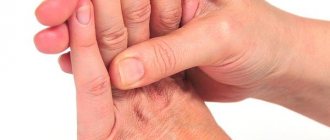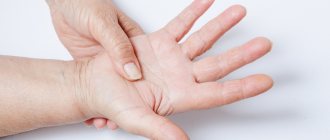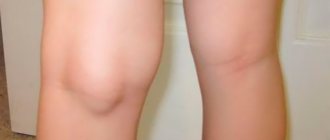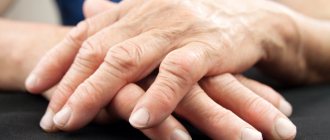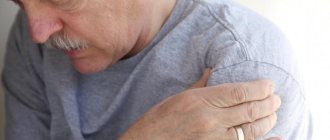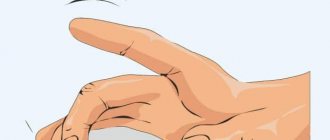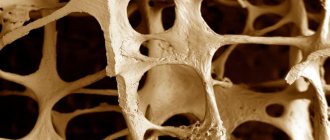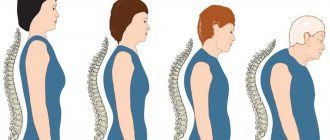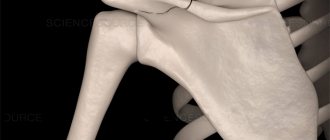What is Restless Legs Syndrome?
Restless legs syndrome is a pathological condition consisting of an obsessive desire to move the legs, caused by a number of certain unpleasant sensations in the lower extremities. These sensations with restless legs syndrome can be pain or aching in the muscles, as well as itching, a burning sensation, crawling distension or twitching in the lower extremities.
Restless legs syndrome
These subjective symptoms more often occur at night or when taking a horizontal body position and relaxing. A significant weakening of the above symptoms occurs with contraction of the muscles of the lower extremities. Therefore, patients with restless legs syndrome have an obsessive need to move the lower extremities.
Causes of muscle pain
The causes of muscle pain can be different. Below are the most common ones.
Muscle injuries
Muscle injuries usually occur as a result of physical activity. They cover specific muscle groups and include:
- sprains - occur due to sudden strong muscle stretching or contraction and are characterized by muscle stiffness and pain that lasts for several days;
- muscle overload, or soreness, occurs during intense training when moving to a new level of load, and is characterized by painful sensations in the muscles that arise due to their microtraumas.
Muscular-tonic syndrome
Muscular-tonic syndrome is a long-term persistent muscle tension, accompanied by the formation of painful compactions in it. This condition is characterized by muscle spasm, which appears reflexively, as a rule, with pathologies of the spine due to irritation of the nerve roots. The syndrome occurs when:
- spinal osteochondrosis;
- intense load on the back;
- long-term static loads.
It is customary to distinguish two types of syndrome:
- diffuse - a muscle area is involved;
- generalized - flexor and extensor muscles are involved.
The most common types of muscular-tonic syndrome are the syndromes of the following muscles:
- anterior wall of the sternum;
- pear-shaped;
- pectoralis minor;
- oblique muscle capitis;
- iliopsoas;
- gastrocnemius;
- backs.
Infectious muscle diseases
Myositis of a parasitic, bacterial and viral nature is an inflammation of the muscles that occurs, including as a result of complications of other diseases. With myositis, all muscles of the body can hurt: the upper and lower extremities and torso. When moving, the pain becomes more pronounced; dense nodules can be felt in the muscles.
With purulent myositis, the pain intensifies and is accompanied by:
- increased body temperature;
- tension of the affected muscle;
- swelling of the sore muscle and redness of the skin over it.
Fibromyalgia
Fibromyalgia is symmetrical pain in the muscles, ligaments and tendons of a chronic nature. It can be localized in the area:
- back of the head;
- chest;
- neck;
- lower back;
- thighs near the knee joint.
More about fibromyalgia
Most often, this pain syndrome occurs in women. In addition to symmetrical pain throughout the body, the following symptoms are present:
- sleep disorders;
- morning stiffness
- chronic fatigue syndrome;
- apnea.
Other causes of muscle pain
Other factors that can trigger muscle pain include:
- rheumatic disease (polymyalgia rheumatica);
- taking medications to lower blood pressure and statins
- systemic lupus erythematosus;
- muscle inflammation of autoimmune etiology;
- deficiency of calcium and potassium in the body.
Treatment for restless legs syndrome
Taking multivitamins, anticonvulsants, and giving up bad habits often help get rid of restless leg syndrome.
Restless legs syndrome is a fairly common complaint in patients suffering from varicose veins for a long time. Chronic venous insufficiency, which occurs with varicose veins, disrupts the electrolyte balance in the tissues of the lower extremities, leading to the appearance of restless legs syndrome. This condition is well known to many patients with varicose veins. In some cases, wearing compression stockings may help, providing some relief. However, after some time, restless legs syndrome returns. Only radical treatment of varicose veins helps patients completely get rid of restless legs syndrome.
Restless legs syndrome is not a symptom exclusively of varicose veins. There are many other causes of restless legs syndrome. It is very likely that a therapist or neurologist will be able to help. However, if you have restless legs syndrome, it is better to visit a phlebologist and undergo a diagnosis of the venous system of the lower extremities.
Diagnosis of restless legs syndrome
If you have varicose veins, lifestyle changes and vitamin supplements will not be able to completely rid you of restless legs syndrome. Only good treatment for varicose veins will be an effective remedy for restless legs syndrome in this situation.
What to do before visiting a doctor.
Do leg exercises regularly, lead a healthy lifestyle, follow a diet and exercise, and visit the pool. It is necessary to wear comfortable shoes with orthopedic insoles, while trying to wear high-heeled shoes or, conversely, ballet flats or sneakers with flat soles as little as possible. In the evening, do a separate contrast shower for your feet - alternating warm and cool water, and place a pillow under your feet at night.
It is certainly necessary to follow these traditional recommendations if your legs ache. However, given the range of possible diseases that can cause this condition, you should not delay visiting a doctor and receiving specialized help.
Ivan Ilyich Kalachev, Ph.D. phlebologist, head of the surgical department of the Clinic of Expert Medical Technologies
Patient Questions About Restless Legs Syndrome
My legs twitch when falling asleep, what should I do?
If your legs twitch when falling asleep, you need to figure out the cause of this phenomenon. Convulsive contractions of the muscles of the lower extremities can be caused by a number of reasons. First you need to visit the following specialists: a neurologist and phlebologist. An ultrasound duplex examination of the veins of the lower extremities must be performed. Having understood the cause of the condition, it will be possible to completely get rid of convulsive twitching at night.
How to treat restless legs syndrome?
To understand how to treat restless legs syndrome, it is necessary to find out the cause of its occurrence. This will require consultations with the following specialists: a neurologist, phlebologist and therapist.
My legs twist a lot at night, what should I do?
If you experience severe leg cramps at night, seek medical attention. A very common cause of this condition is chronic venous insufficiency, complicating varicose veins.
Pain in legs at night when lying down, which doctor should I go to?
If you have pain in your legs at night when lying down, the first doctor you should visit is a phlebologist. At the beginning, it is necessary to exclude venous pathology. Perhaps a phlebologist will completely solve your problem.
Diagnosis of muscle pain
Before prescribing treatment for muscle pain, it is necessary to conduct a diagnosis that will identify the root cause of their occurrence. Depending on the nature of your pain, the CELT Pain Clinic may refer you to one of the following specialists:
- traumatologist;
- rheumatologist;
- infectious disease specialist
As a rule, diagnosis is based on the history of the disease and its clinical manifestations. To confirm or differentiate the cause of myalgia, the following may be used:
- X-ray examinations;
- Magnetic resonance imaging;
- CT scan;
- ultrasonography;
- laboratory research methods;
- muscle biopsy.
Aching pain at night
How to deal with them? Why do my knees twist at night? Possible causes are serious diseases such as osteoporosis, arthrosis or arthritis. It is quite difficult to stop the development of these pathologies. The appearance of pain in the knee joint may indicate that the disease has already gone far enough. It is worth considering that arthrosis can develop not only in older people. Very often, even at the age of 25, people suffer from this unpleasant disease. It can develop due to constant stress on the knee joints, associated, for example, with professional activities. Often this disease affects young mothers, professional athletes and loaders. The cartilage gradually begins to deteriorate, which causes an unpleasant aching sensation that does not go away even at night.
Inflammatory processes
Why does he twist his knees? One of the most common causes is inflammation in the joints.
Here are just some of the diseases that can cause them:
- Arthritis: this pathology may indicate the beginning of the first stage of development of polyarthritis. The disease affects several groups of joints at once. The first symptoms of the disease are swelling, redness, severe pain, especially at night and when weather conditions change.
- Bursitis: This disease is associated with inflammation of the joint capsule. It is this element that protects the joint from infections and mechanical damage. The first signs of inflammation are swelling and redness, and severe knee pain.
- Tendinitis. With this disease, the inflammatory process affects the ligaments and tendons. As a result, the legs become very swollen, and discomfort appears while running or walking. Pain may also occur in the lower leg and thigh.
- Becker's cyst. The location of the inflammatory process is the back surface of the lower leg, slightly below the popliteal notch. The disease causes severe pain that intensifies when bending the leg.
Arthrosis
What is this disease? One of the possible reasons why the legs twist from the knees to the feet is arthrosis. This disease is characterized by severe pain. This is due to the destruction of articular cartilage and destruction of the synovium.
The following symptoms are characteristic of arthrosis:
- Crunching in the knees and severe aching pain.
- Fast fatiguability.
- In the later stages of the disease, numbness and swelling of the knees are observed. In severe cases, complete immobilization may occur.
If treatment for this disease is not started in a timely manner, the kneecap may gradually shift and become deformed.
Pathological factors
If you twist the muscles and joints of your leg regularly, and the symptom gets worse day by day, there are diseases that entail a certain problem. It could be:
- Arthritis of rheumatoid type.
- Kidney failure.
- Blood clots in the veins of the lower extremities.
- Problems with the arteries.
- Pathologies of the endocrine system.
- Leg injuries - bruises, dislocations, etc.
After fractures, no matter how correctly and well the bones heal, in bad weather and after long marches the legs will hurt greatly. This cannot be changed; all that remains is to take medications that relieve pain.
What to do if your legs twist?
Getting rid of bone, muscle and joint problems is not always easy. A correct diagnosis determines the treatment methods prescribed by a specialist. This requires honesty in a conversation with the doctor and detailed information about how and what exactly hurts. If laboratory tests are inconclusive, the patient's testimony will help the physician determine the problem.
Drug treatment
To prescribe the right and appropriate drug, different drugs may be tested in small doses in turn. If the drug is effective, the dosage is increased to achieve optimal effectiveness of therapy. Polytherapy is also common, based on combining different medications in one course.
When your legs are twisting due to problems with the vascular system, you should be treated with agents that increase vascular tone and thin the blood. The first include “Detralex” and “Normaven”, the second - “Thrombo ACC”, “CardiASK”.
Also (strictly as prescribed by a doctor!), medications included in the following categories of medications can be used:
- sedatives and sleeping pills - Clonazepam, Restoril, Halcion;
- dopaminergic drugs – Sinemet, Pergolide, Permax, Parlodel;
- anticonvulsants – Gabapentin, Neurontin.
